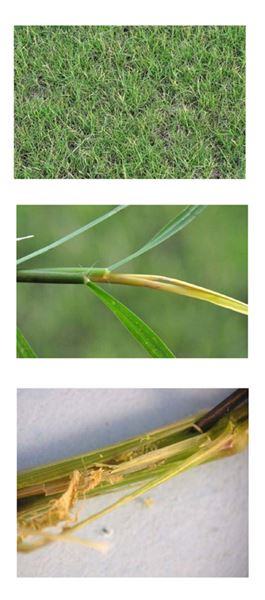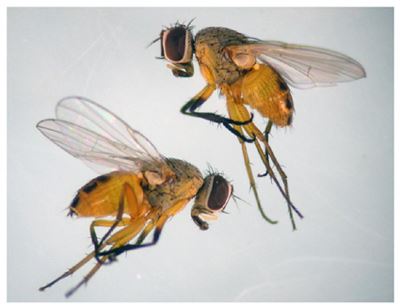Bermudagrass Stem Maggot Found In Allen County, Kentucky
STEVE OSBORNE
SCOTTSVILLE, KY.
The bermudagrass stem maggot was found in three Allen County
bermudagrass hayfields this year. It was discovered in Georgia in 2010.
Native to Japan, Indonesia, India, and Hawaii, this small fly has
spread rapidly across the Southeast, causing yield and quality losses in
bermudagrass pastures and hayfields. Damage varies with the growth
stage of the grass; numbers of flies present, which increases during the
summer; and drought stress.

Figure 1. Yellowed bermudagrass stems caused by bermudagrass stem maggot. Infested fields have a frosted appearance.
Figure 2. Close up of infested stem. The maggot usually leaves the stem before the terminal turns yellow.
Figure 3. Split infested stem showing shredded tissue and waste material produced by the maggot.

Figure 4. Bermudagrass stem maggot flies are about 1/8-inch long. The
thorax is light gray; the abdomen is yellow with some distinct dark
spots.
Maggots hatching from eggs laid on the plants attack at a node.
Feeding kills leaf blades beyond the damaged area; the lower leaves stay
green.
Research is underway to evaluate management options. While the
acreage of bermudagrass grown for hay in Kentucky is small, growers
should be watching for this insect in 2014. A sweep net is the best tool
to use to check fields efficiently.
Information on management of this insect is available at - http://www.aces.edu/pubs/docs/A/ANR-1462/ANR-1462.pdf.∆
DR. LEE TOWNSEND: Extension Entomologist, University of Kentucky
STEVE OSBORNE: Allen County Agent for Agriculture & Natural Resources, University of Kentucky Extension